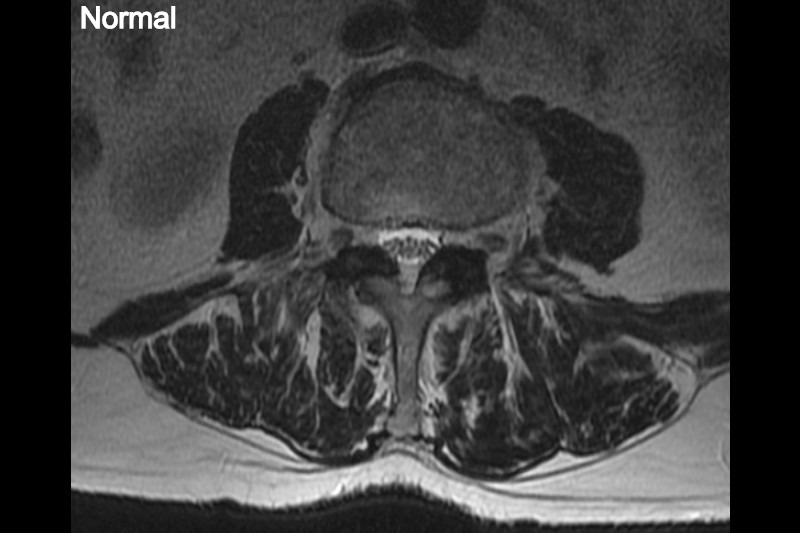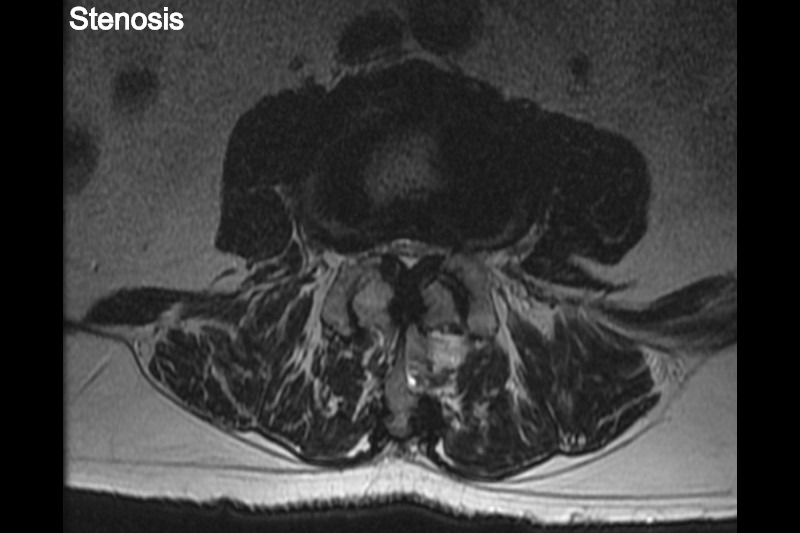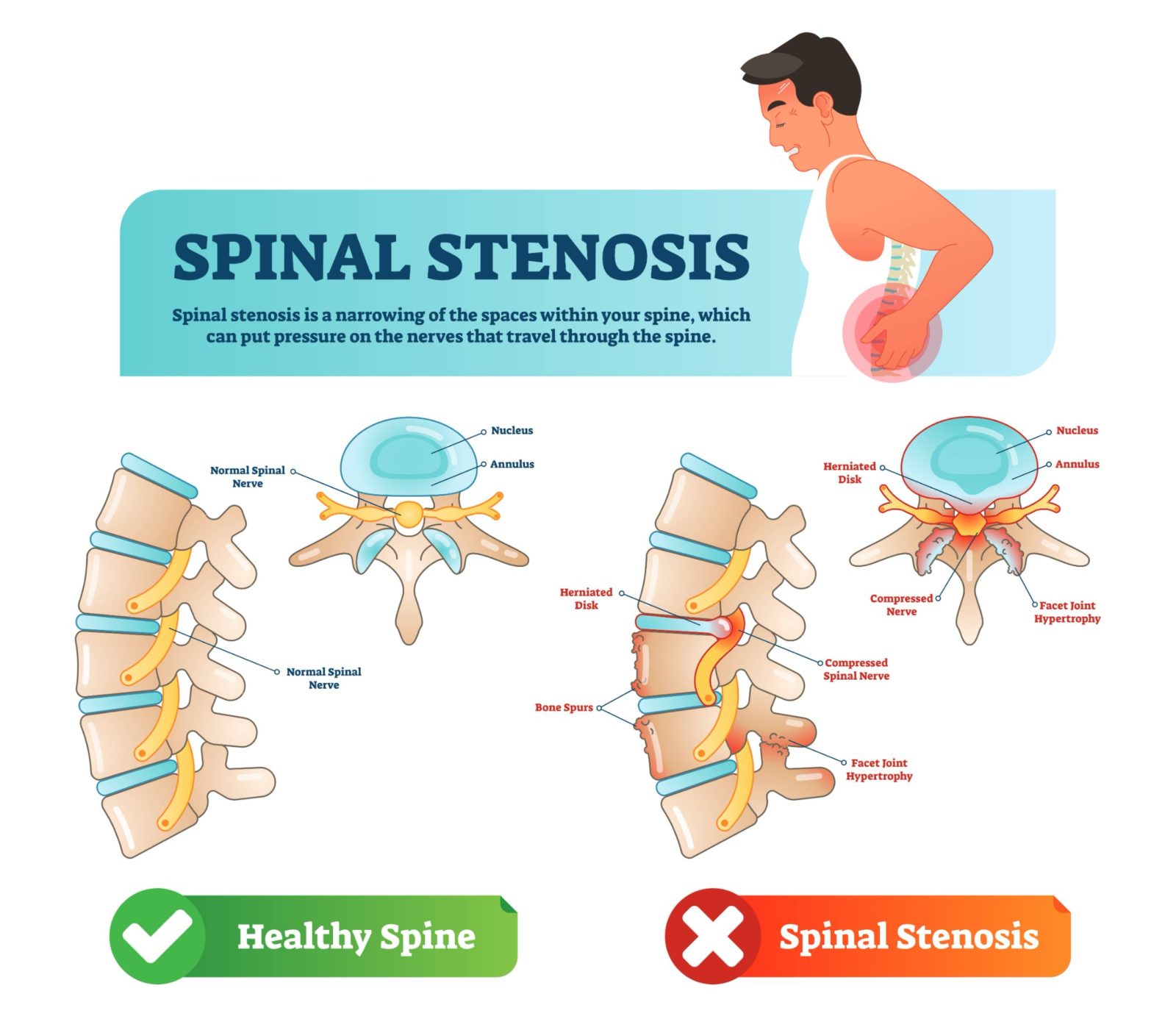Spinal stenosis is a medical condition where the spaces within your spine narrow, which can put pressure on the nerves traveling through the spine. Often occurring in the lower back and the neck, it can result from wear-and-tear changes in the spine related to osteoarthritis. At Comprehensive Spine Care, P.A. in New Jersey, we are committed to diagnosing, treating, and helping patients manage spinal stenosis, ensuring they lead a comfortable and active life.
- Spinal Stenosis is a narrowing of the spinal canal that results in pressure on the spinal cord or spinal nerves.
- Spinal Stenosis may occur anywhere in the cervical (neck area), thoracic (chest area) or lumbar (lower back) spine.
- The narrowing in the spinal canal is the result, often due to aging, of changes in the anatomic structures in the spine including the intervertebral discs, the facet joints, and spinal ligaments.


Symptoms:
The symptoms of spinal stenosis vary according to where in the body the stenosis is present and whether there is significant pressure on the spinal cord or spinal nerves. Symptoms may be relatively mild to severe depending on the degree of stenosis.
“The narrowing in the spinal canal is the result of changes in the anatomic structures in the spine.”
Symptoms That Shouldn’t Be Ignored
- Numbness or tingling in a hand, arm, foot, or leg
- Muscle weakness
- Pain or cramping in one or both legs when standing for long periods or when walking
- Severe neck pain
- Problems with balance and walking
- Bowel or bladder dysfunction in severe cases
Causes:
Spinal Stenosis is frequently the result of age-related changes in the spine, however there are people born with relatively narrow spinal canals. Other causes of spinal stenosis include:
- Arthritis in the spine
- Disc Degeneration
- Herniated or bulging discs
- Spondylolisthesis (slipping of one vertebra over another)
- Trauma
- Previous surgery
- Tumors
Symptoms of Lumbar Spinal Stenosis:
(Spinal Stenosis in the lower back)
- Muscle Spasm in the lower back
- Moderate to Severe pain in the lower back and buttocks
- Lumbar Radiculopathy (Sciatica). The symptoms from a nerve compressed because of lumbar stenosis (pinched nerve) include pain, burning, numbness, or tingling from the lower back into the buttocks, thighs, legs and feet.
- Neurogenic Claudication – sometimes described as ‘heaviness’, ‘aching’ or ‘cramping’ in the buttocks and/or legs
- Weakness may result in the muscles of the leg and/or ankles if there is significant pressure on the nerves
- Pain is typically brought on by walking and relieved by sitting

Symptoms of Cervical Spinal Stenosis:
(Spinal Stenosis in the neck area)
- Muscle Spasm in the neck and shoulder
- Moderate to Severe pain in the neck and around the shoulder blades (scapula)
- Cervical Radiculopathy. The symptoms from a nerve compressed because of lumbar stenosis (pinched nerve) include pain, burning, numbness, or tingling from the neck into the shoulders, arms, forearms, and hands.
- Weakness may result in the muscles of the arms and hands if there is significant pressure on the nerves
- Cervical Myelopathy: The most serious condition that may result from cervical stenosis. Symptoms of myelopathy include loss of fine motor skills in the hands (difficulty buttoning a shirt, changes in handwriting, trouble putting on or taking off jewelry etc.), loss of balance, or loss of bowel or bladder control.
Treatments:
The majority of individuals with spinal stenosis do not require surgery. Common non-surgical treatment options include the following options:
- Anti-inflammatory medications
- Epidural Injections
- When pain symptoms are severe, if there is significant muscle weakness, if myelopathy is present, or if your overall condition deteriorates surgery may be necessary. The surgeons at Comprehensive Spine Care will develop a treatment plan based on your symptoms, physical exam and MRI results.
- Surgery for Lumbar Stenosis typically consists of a Lumbar decompression (Laminectomy or Laminotomy).
- Stabilization of the spine may also be necessary if there is instability present (Anterior Lumbar Interbody Fusion, Posterior Lumbar Fusion, Lateral Lumbar Fusion.)
For cervical stenosis, the most common surgical options are Posterior Cervical Discectomy/ Foraminotomy, Anterior Cervical Discectomy, and Fusion, or an Artificial Disc Replacement.
The Necessity for Addressing Spinal Stenosis
If left untreated, spinal stenosis can lead to long-term nerve damage. Early diagnosis and treatment can prevent this. The pressure exerted on the spinal cord or the nerve roots can lead to debilitating pain and even paralysis. Furthermore, the constant discomfort and pain can drastically reduce the quality of life, making daily activities cumbersome. Lastly, advanced cases might lead to a significant loss of mobility, making timely intervention crucial.
A Comprehensive Approach to Treatment
Understanding the cause and the severity of spinal stenosis is paramount. At Comprehensive Spine Care, P.A., the treatment process involves:
- Diagnosis: Utilizing advanced imaging tests like X-rays, MRI, or CT scans to understand the extent and location of the narrowing
- Conservative Treatments: Physical therapy, medications, and injections to alleviate pain and improve mobility
- Surgical Intervention: In cases where conservative treatments don’t provide relief, our doctor might recommend surgery like laminectomy, laminotomy, or spinal fusion to create more space for the nerves or spinal cord.
Preventing Spinal Degeneration
While you can’t entirely prevent spinal stenosis, especially if it’s due to genetic factors or the natural aging process, you can:
- Stay Active: Regular exercise strengthens the muscles supporting your back.
- Maintain Good Posture: Proper posture minimizes spinal stress.
- Bone Health: Ensure you get enough calcium and vitamin D to prevent osteoporosis, a potential cause of spinal stenosis.
- Regular Check-ups: Monitoring any back or neck pain can help in early detection.
Embracing A Positive Future
Spinal stenosis, though challenging, doesn’t mean a life of perpetual discomfort. With the right treatment and management at Comprehensive Spine Care, P.A., many patients reclaim an active lifestyle. Regular follow-ups, lifestyle modifications, and adhering to the doctor’s advice can make a significant difference in managing the condition.
Frequently Asked Questions
What is spinal stenosis?
Spinal stenosis is a condition where the spaces within the spine narrow, exerting pressure on the nerves. It primarily occurs in the lower back and neck due to wear-and-tear changes associated with osteoarthritis.
How is spinal stenosis treated at Comprehensive Spine Care, P.A.?
Our approach includes an accurate diagnosis using advanced imaging tests and conservative treatments such as physical therapy and medications. Surgical interventions like laminectomy or spinal fusion might be recommended for cases where these treatments are ineffective.
Can spinal stenosis be prevented?
While genetic and aging factors can’t be altered, measures like maintaining an active lifestyle, ensuring good posture, and prioritizing bone health can help in minimizing the risk of spinal stenosis. Regular check-ups can also aid in early detection and management.
Connect with a Specialist
Your spinal health shouldn’t be left to chance. If you suspect you have symptoms of spinal stenosis or need a reliable opinion on spine care, don’t hesitate to reach out to Comprehensive Spine Care, P.A. in New Jersey. Contact us today at (201) 634-1811 and embark on a journey towards better spinal health.










